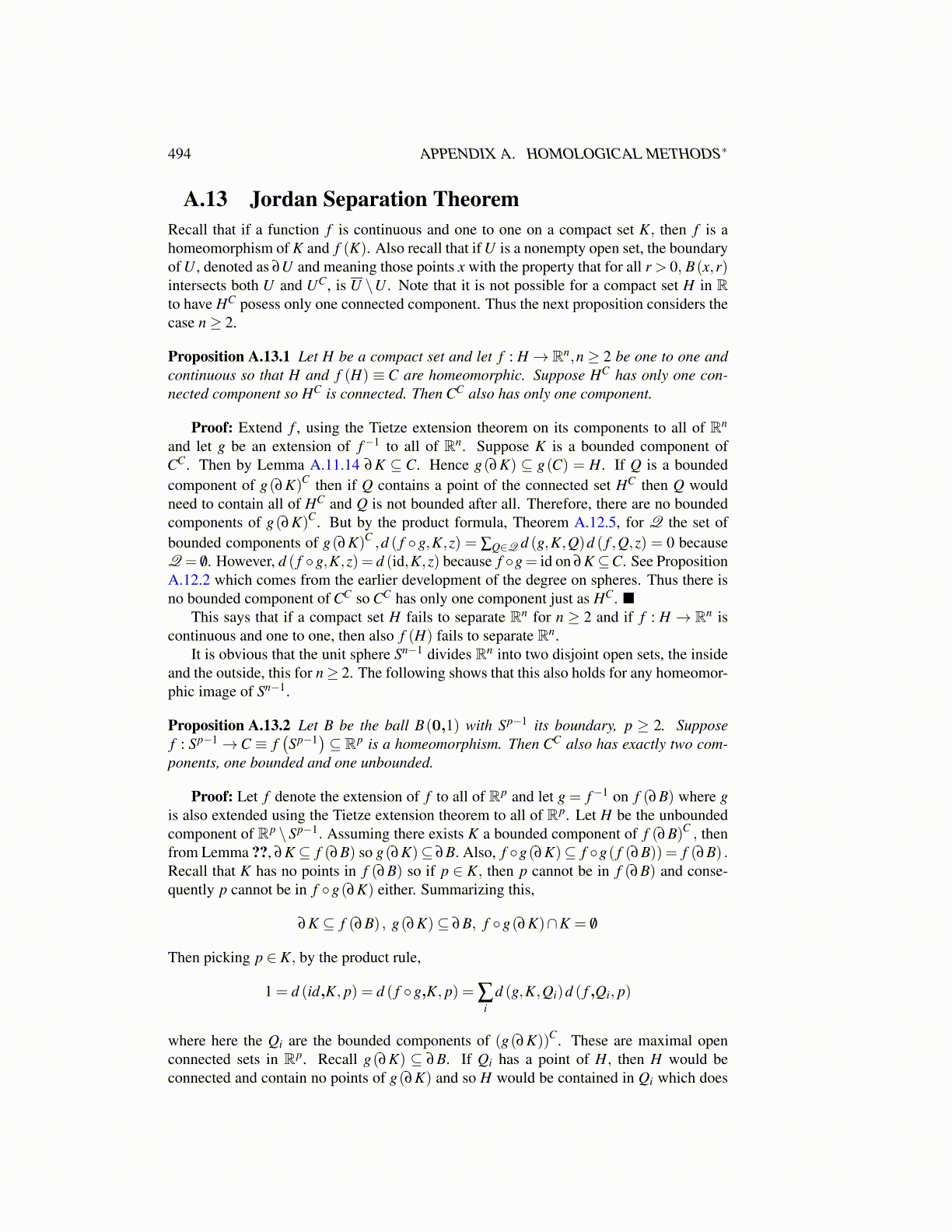
494 APPENDIX A. HOMOLOGICAL METHODS∗
A.13 Jordan Separation TheoremRecall that if a function f is continuous and one to one on a compact set K, then f is ahomeomorphism of K and f (K). Also recall that if U is a nonempty open set, the boundaryof U , denoted as ∂U and meaning those points x with the property that for all r > 0, B(x,r)intersects both U and UC, is U \U . Note that it is not possible for a compact set H in Rto have HC posess only one connected component. Thus the next proposition considers thecase n≥ 2.
Proposition A.13.1 Let H be a compact set and let f : H → Rn,n ≥ 2 be one to one andcontinuous so that H and f (H) ≡ C are homeomorphic. Suppose HC has only one con-nected component so HC is connected. Then CC also has only one component.
Proof: Extend f , using the Tietze extension theorem on its components to all of Rn
and let g be an extension of f−1 to all of Rn. Suppose K is a bounded component ofCC. Then by Lemma A.11.14 ∂K ⊆ C. Hence g(∂K) ⊆ g(C) = H. If Q is a boundedcomponent of g(∂K)C then if Q contains a point of the connected set HC then Q wouldneed to contain all of HC and Q is not bounded after all. Therefore, there are no boundedcomponents of g(∂K)C. But by the product formula, Theorem A.12.5, for Q the set ofbounded components of g(∂K)C ,d ( f ◦g,K,z) = ∑Q∈Q d (g,K,Q)d ( f ,Q,z) = 0 becauseQ = /0. However, d ( f ◦g,K,z) = d (id,K,z) because f ◦g= id on ∂K ⊆C. See PropositionA.12.2 which comes from the earlier development of the degree on spheres. Thus there isno bounded component of CC so CC has only one component just as HC. ■
This says that if a compact set H fails to separate Rn for n ≥ 2 and if f : H → Rn iscontinuous and one to one, then also f (H) fails to separate Rn.
It is obvious that the unit sphere Sn−1 divides Rn into two disjoint open sets, the insideand the outside, this for n≥ 2. The following shows that this also holds for any homeomor-phic image of Sn−1.
Proposition A.13.2 Let B be the ball B(0,1) with Sp−1 its boundary, p ≥ 2. Supposef : Sp−1→C ≡ f
(Sp−1
)⊆ Rp is a homeomorphism. Then CC also has exactly two com-
ponents, one bounded and one unbounded.
Proof: Let f denote the extension of f to all of Rp and let g = f−1 on f (∂B) where gis also extended using the Tietze extension theorem to all of Rp. Let H be the unboundedcomponent of Rp \Sp−1. Assuming there exists K a bounded component of f (∂B)C , thenfrom Lemma ??, ∂K ⊆ f (∂B) so g(∂K)⊆ ∂B. Also, f ◦g(∂K)⊆ f ◦g( f (∂B)) = f (∂B) .Recall that K has no points in f (∂B) so if p ∈ K, then p cannot be in f (∂B) and conse-quently p cannot be in f ◦g(∂K) either. Summarizing this,
∂K ⊆ f (∂B) , g(∂K)⊆ ∂B, f ◦g(∂K)∩K = /0
Then picking p ∈ K, by the product rule,
1 = d (id,K, p) = d ( f ◦g,K, p) = ∑i
d (g,K,Qi)d ( f ,Qi, p)
where here the Qi are the bounded components of (g(∂K))C. These are maximal openconnected sets in Rp. Recall g(∂K) ⊆ ∂B. If Qi has a point of H, then H would beconnected and contain no points of g(∂K) and so H would be contained in Qi which does